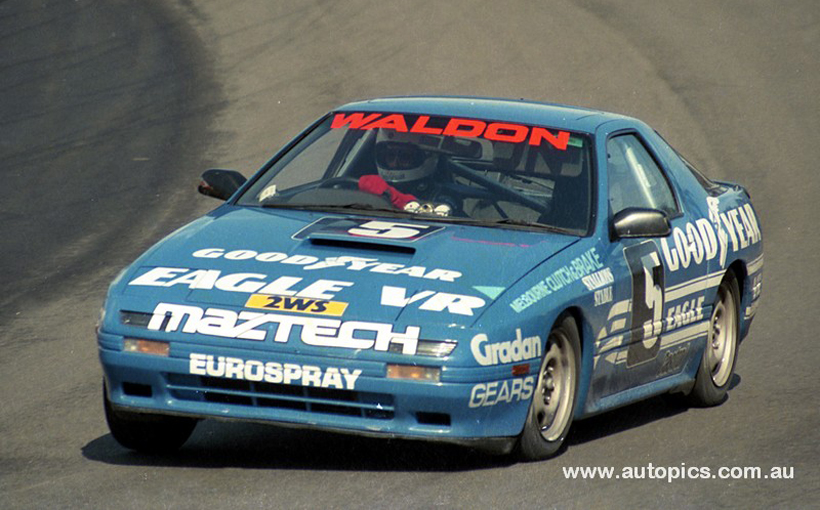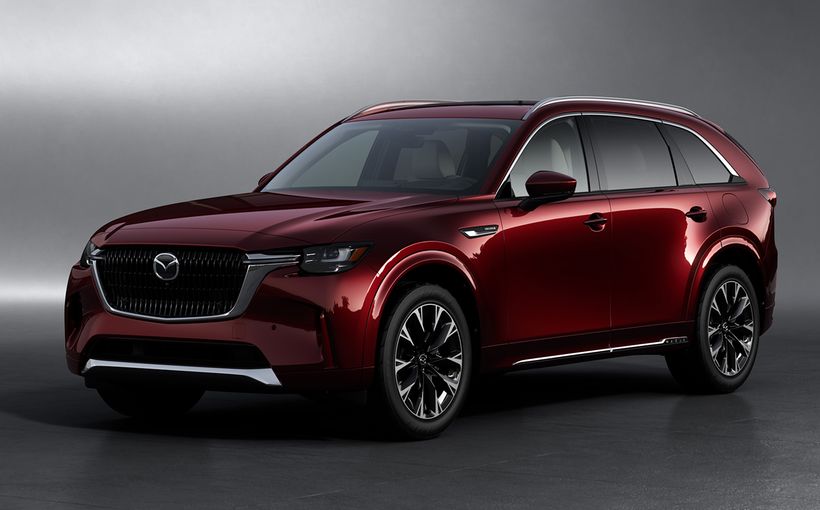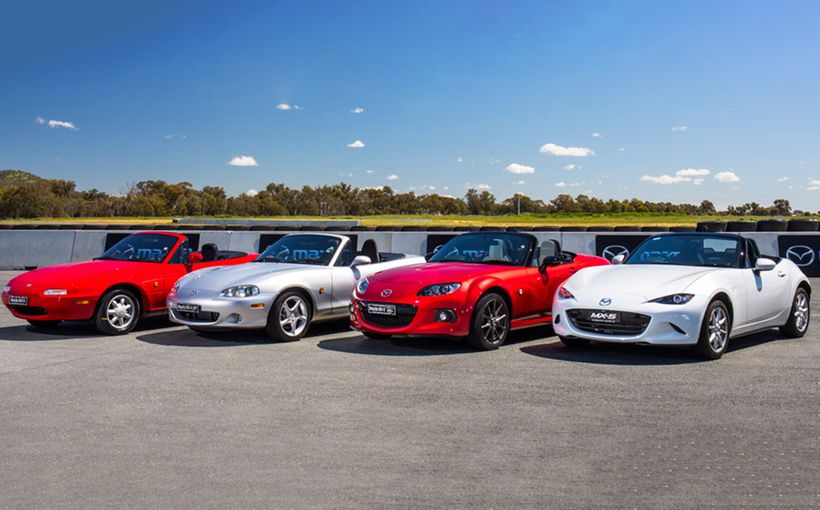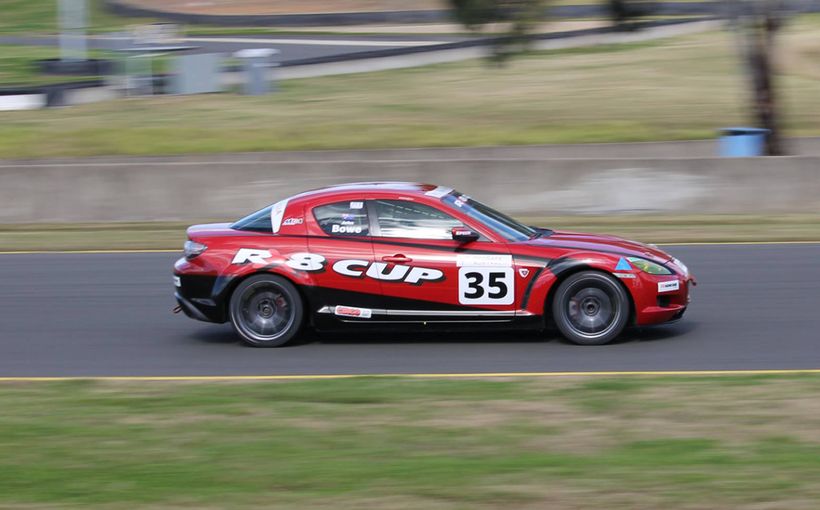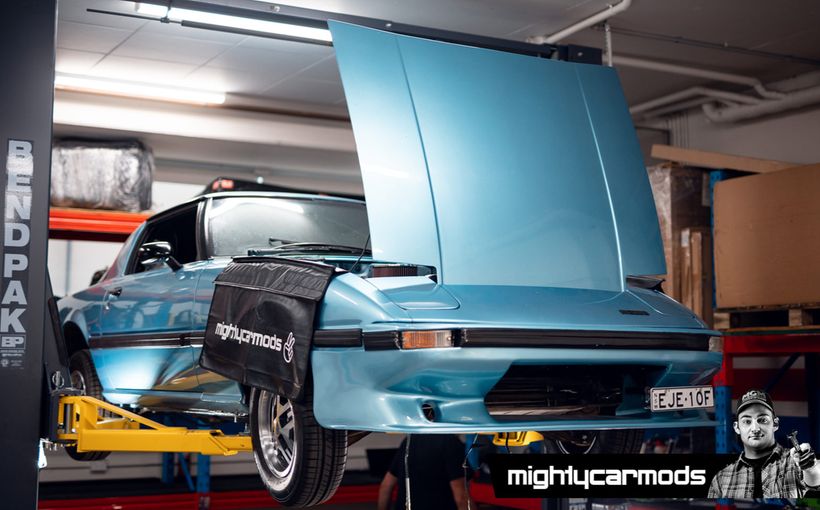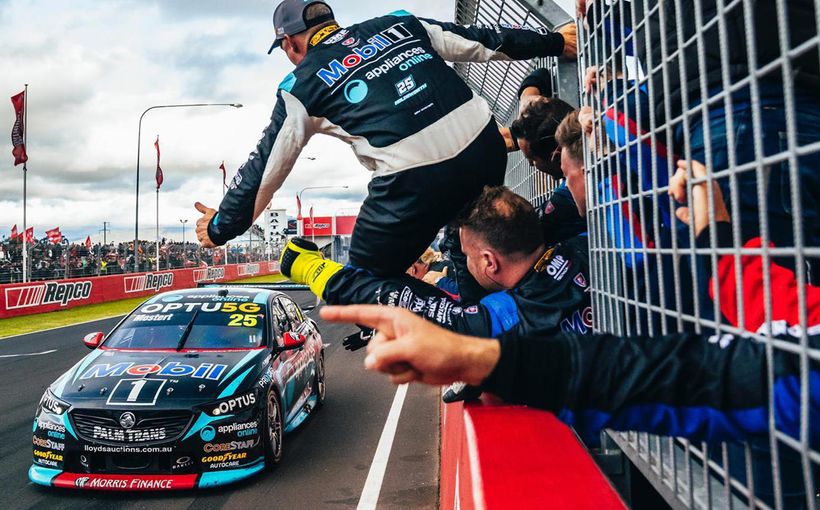Mazda RX-7 Series IV: the turbocharged Bathurst supercar that never made it

The giant-killing success of Allan Moffat’s 12A and 13B rotary-powered Mazda RX-7s in Aussie touring car racing during the 1980s Group C era was a stunning achievement. What raised the pulse of Mazda product planners even more, though, was the prospect of its long-awaited second generation replacement taking to the track with turbocharged power.
On paper the RX-7 Series IV (the original RX-7 covered Series 1 to 3), which was due for release in 1986, looked like a natural-born racer. Its Porsche 944-inspired aerodynamic styling housed several major mechanical enhancements. The previous live rear axle was replaced with a highly sophisticated independent rear suspension with dynamic toe angle adjustment for sharper handling, rack and pinion steering replaced the previous recirculating ball type and four-wheel disc brakes were standard.
In Group C trim this would have been a formidable competitor. Although the Series IV was about 50 kgs heavier than its featherweight predecessor, the turbocharged version of the twin-rotor 13B engine offered huge untapped potential.
Its two 654cc rotors had a combined cubic capacity of 1308cc. However, under the FIA’s engine equivalency rules, a rotary engine was considered to be twice as efficient as a conventional piston engine. Therefore the 13B’s nominal capacity rating was doubled to 2616cc. Adding a turbocharger required another equivalency factor of 1.4 to be applied, to determine the engine’s total cubic capacity (2616cc x 1.4 = 3662cc).

In other words, the extra grunt from the turbo was supposed to provide power output roughly equal to that of a naturally aspirated engine of just under 3.7 litres, but by then the FIA’s turbo equivalency factor of only 1.4 was seriously outdated. F1 racing at the time proved it, with turbocharged 1.5 litre engines producing power outputs in excess of 1000 bhp in qualifying trim!
The mind boggles at what Mazda might have been able to achieve with a turbocharged rotary Group C car. Power outputs in excess of the strongest 5.0 litre V8 Commodores and near-6.0 litre Ford and Chevrolet V8s of the era would have been achievable, combined with a light sub-1200 kg kerb weight which easily undercut all of them. Its power to weight ratio would have been stunning.
Internally, expectations were high in Japan that Mazda would continue its local touring car involvement with the new RX-7 Turbo. However, according to former competitions boss Allan Horsley, Australia’s switch from home-grown Group C touring car rules to the FIA’s international Group A regulations for 1985 was one of two major factors that killed any chance of a turbocharged RX-7 touring car warrior becoming a reality.
“When they went to the international rules with the World Touring Car Championship and all, for Mazda it went from being a local racing program under Group C to a global racing program under Group A and the difference in investment required was massive,” Horsley told Shannons Club.

“Any motor racing program coming from Japan (Toyo Kogyo) wasn’t very strong. Remember that Mazda was a small company compared to some of the other manufacturers involved and those global motor sport programs cost megadollars. It took a huge amount of money just to get a car homologated with the FIA, so to take on a global touring car program was out of the question.
“From memory it also didn’t comply (as a touring car) because they changed the rules slightly. I think it was the height of the back seat relative to the roof or something like that. That rule applied to the first car too but they couldn’t make the second one comply with the new ruling.”
Even though the RX-7 Turbo did not become either a Group C or Group A touring car, it did prove its competition credentials in local ‘showroom stock’ (supposedly) production car racing by winning the 1988 Australian Production Car Championship.
Although the RX-7 Turbos driven by Garry Waldon and Peter Fitzgerald were clearly in a class of their own that year, the Mazdas were under constant scrutiny by officials and other competitors in regards to their legality – even Waldon and Fitzgerald protested each other’s cars.
It was, on reflection, an ugly season-long fight peppered with protests and ill-feeling. Some would say, quite rightly, that production car racing has always been tailor-made for rule-bending. However, the introduction of turbocharged cars raised it to a whole new level that proved impossible to police.

Group E Production Car Racing: The Turbo Scourge
From 1984 to 1987, the Group E ‘showroom stock’ class was dominated by the Mitsubishi Starion largely thanks to its powerful turbocharged engine which more than compensated for its relatively high 1265 kg kerb weight.
Prior to that, turbos had been banned from Group E since its inception in 1981 on the grounds that they would prove too difficult to police - and that’s exactly what happened once the turbo genie was out of its bottle.
Accusations of competitors using illegally high levels of turbo boost that could not be easily detected started to come thick and fast, causing a nightmare for scrutineers and plenty of bad blood within the category.

Finally, in 1987 CAMS announced that Group E would get its own national championship, based on a series of qualifying races held in each state from which the leading drivers would compete in the all-important decider at Victoria’s Winton Motor Raceway in September.
CAMS also announced that 100-plus octane aviation fuel would be banned prior to the APCC final, in a vain attempt to stop all the bitter infighting over illegal turbo boost. Despite the governing body’s best intentions, as far as the competitors were concerned there was no turning back. Big boost was here to stay. It just meant having to rebuild engines after every second race.
Despite some quality competition, the first Australian Production Car Championship fell to Peter Fitzgerald’s Starion after he claimed pole position and won the two 30-lap heats.

After several years of dominance, though, the Starion’s reign as the king of production cars came to an abrupt end in 1988 with the arrival of the latest unleaded JD model, which critically featured a smaller turbocharger. This was the kiss of death for the Mitsubishi coupe in a category that had become hopelessly addicted to turbocharged power.
Most of the leading Starion drivers dropped the car like a hot cake for 1988, including Fitzgerald who swapped to the Series IV Mazda RX7 Turbo. This striking new sports car in Garry Waldon’s hands had been making life increasingly hard for ‘Fitzy’ towards the end of the Starion’s reign and would take its place as the new dominant force in Group E. Its only apparent weakness in competition was a tendency for the turbocharged rotary engine to overheat.

1988 APCC: a two horse race
Bouyed by the success and strong competitor support of the initial title, governing body CAMS decided to hold an eight-round championship in 1988 visiting all states except WA. Four of the rounds supported the Shell Australian Touring Car Championship for Group A touring cars and enjoyed national live TV coverage as part of the Seven Network’s telecasts.
The series also attracted a naming rights sponsor in Japanese tyre manufacturer Yokohama. This not only provided a healthy prizemoney pool but also some corporate polish in management and promotion, plus the opportunity to employ a full-time series scrutineer in Greig Black to keep everyone in line.
However, Black faced a very difficult task. In 1987 CAMS had experimented with an electronic turbo boost measuring device fitted to the inlet manifold which could be set to any pressure to suit the different boost levels used by different makes of cars. However, these units proved inconsistent and were soon abandoned.
For the 1988 APCC, the scutineers followed the latest overseas trend by fitting new F1 style ‘pop-off’ valves which released excess boost pressure once a pre-set limit was exceeded, but these units generated just as much flak from competitors as the electronic units used the previous year.

CAMS also ruled that catalytic converters could be removed, which clearly favoured turbocharged cars like the Mazda RX-7 as they were considered a major cause of engine overheating in competition use.
So Garry Waldon and Peter Fitzgerald went with the RX-7 Mazda Turbos. Brad Jones stuck with the Starion (along with Tony Scott) due to his strong Mitsubishi ties, but the majority of competitors chose the more affordable VL Commodore Turbo with its Nissan-sourced inline six.
The good news was that the Commodores had ample grunt on tap and provided plenty of hard, close and entertaining racing. The bad news was that they were generally fighting over third place, because they rarely had a chance of beating the two Mazdas.
The Commodore Turbos dominated the opening round at Symmons Plains in Tasmania with Mark Gibbs and Mike Preston claiming a 1-2 finish in a pair of cars expertly prepared by Ron Gillard. However, the result had flattered to deceive.

Neither of the two Mazda RX-7s were in attendance, as Waldon’s Goodyear-backed car had suffered chronic engine overheating in a race meeting at Calder the week prior and his Maztech crew under Gerry Burgess decided to skip the Tassie trip to try and cure the problem. The championship rules allowed a competitor to drop his worst round, so they exploited the opportunity.
Fitzgerald also drove a Commodore Turbo in Tassie due to engine damage in his RX-7 at Calder. In Waldon’s absence he wanted to try the turbocharged Holden in the first round to see if it was a better bet than the Mazda, but after finishing third behind the two Gillard-prepared cars he switched to the RX-7 Turbo full-time from round two.
In the lead-up to round two at Winton in Victoria, Waldon had switched his car preparation from Maztech to Jonespeed under renowned rotary whiz Barry Jones. The change brought immediate results, as Waldon’s car appeared to finally have overcome most of the chronic overheating problems that had plagued it from the start. He took pole position and powered to a convincing victory over Fitzgerald, with Mike Preston the first of the Commodores in third.

With the unleaded Starion clearly on a hiding to nothing in 1988, Kim Jones was again on the warpath at Winton, lodging a protest against the ride height of Fitzgerald’s car. However, after the scrutineers had pulled out all the springs and thoroughly measured everything the Yokohama-backed Mazda was declared legal.
Waldon again had Fitzgerald’s measure at Adelaide International Raceway for round three, claiming another pole position and race win with Preston again the top-placed Holden in third and apparently powerless to stop the RX-7 juggernaut.
Waldon took his third pole position and race win at Amaroo Park’s fourth round, but his mighty Mazda was coming under increasingly close scrutiny. During a visit to inspect the car at its Sydney workshop prior to the Amaroo meeting, category scrutineer Greig Black detected several anomalies in the Jonespeed-prepared car that he demanded be corrected before the race.
Waldon appeared to be pushing his luck, because if he was found guilty of any further indiscretions after a 1987 bust at Calder for tampering with the catalytic converter, he faced an instant six-month license suspension and his championship would be over. But then, to succeed in Group E production car racing, cars always had to operate on a knife-edge of legality.

The Mazda RX-7 Turbo ranks expanded to three at Lakeside’s fifth round in Queensland, when former Ford employee Ken Douglas gave up on his Laser Turbo and switched to the Japanese sports car. Given that his new RX-7 Turbo was straight off showroom floor, Douglas’s sixth fastest time in qualifying was impressive given that his suspension tuning had consisted of merely pushing the ‘sport’ mode button.
Fitzgerald took his first pole position in the RX-7 in convincing style but it all went pear-shaped in the race after he and Mark Gibbs made contact at turn one, which sent the black Mazda off the circuit losing many placings. As Waldon powered home to his fourth win on the trot, Fitzgerald could only salvage sixth place.
He was all but prepared to concede defeat by the time the APCC battle arrived at Sydney’s Oran Park for round six. However, in an amazing turnaround of fortunes, Fitzgerald scored a dominant win while his arch rival Waldon suffered a badly overheating engine that was almost dead as it spluttered across the finish line in ninth place. This surprise result put Fitzgerald in front on points. And with only two rounds to go it injected new life into the championship battle, as Waldon's car still seemed vulnerable to overheating.

Fitzgerald appeared to have finally gained the upper hand at the right time of the year, thanks largely to a new CAMS-approved exhaust system fitted for the penultimate round at Melbourne’s Sandown Park.
The Yokohama-backed RX-7 driver nailed pole position by a staggering 1.6 seconds and in the race managed to power away from Waldon at more than one second per lap on his way to a dominant win.
He maintained that momentum for the winner-take-all final at Melbourne’s Calder Park, claiming his third pole position in a row. Waldon, who was clearly frustrated by his arch rival’s sudden burst of late season pace, had noticed that Fitzgerald was shifting gears much later than him and lodged a protest against the Yokohama car’s gearbox and diff ratios. These were thoroughly checked and cleared, raising the ire of race officials growing tired of Group E’s history of vexatious protests.
The pressure seemed to be getting to Waldon, particularly after Fitzgerald leapt into the lead from pole position and Waldon ran off the track on lap two and lost crucial time to the race leader. However, just when it looked like Fitzgerald would cruise home to a comfortable championship win, Waldon unleashed an astonishing turn of speed to quickly reel in Fitzgerald, pass him and then drive on to victory!

Not surprisingly, both the Waldon and Fitzgerald cars were impounded after the race with both engines being stripped and inspected. A clearly miffed Fitzgerald also protested the winning car on four points, which included bodywork, ECU, water pump pulley and brake bias compensator.
Much to Fitzgerald’s dismay, the winning car was cleared of all charges and Garry Waldon was declared the 1988 Australian Production Car champion, with five wins from seven starts giving him a slender winning margin of five points. Mazda also won the Manufacturer’s Award with a perfect score of seven wins, after dropping its worst score which was the RX-7 Turbo’s no-show at the opening round.
The Mazda RX-7 Series IV may not have made it as a local Group C touring car contender or global Group A warrior, but its championship success in local production car racing proved its credentials as a fast, rugged and highly competent sports car worthy of wearing the revered RX-7 badge.

